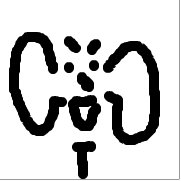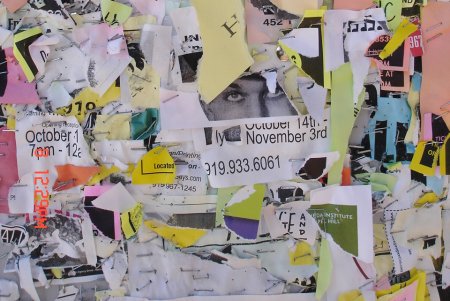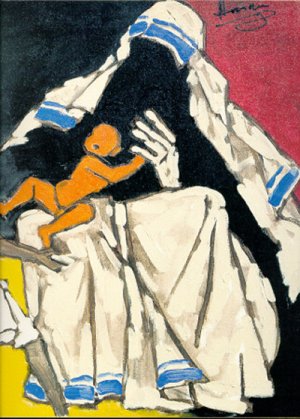It's a pleasant coincidence that Matt Kirschenbaum posted an introduction to Nora, the data-mining literary studies collaborative project he is involved with, just as I've been working on my own post on a proposed project to use search and semantic tagging (del.icio.us and other XML-based services) to study the representation of texture in literary texts. In his post, Matt asks:
Literary scholars, however--here the force of Moretti’s arguments make themselves felt--traditionally do not contend with very large amounts of data in their research. A significant component of our work is therefore basic research in the most literal sense: what kinds of questions do we seek to answer in literary studies and how can data mining help, or--more interestingly--what new kinds of questions can data mining provoke?
The following is my own proposal for a very specific kind of linguistic data that could be gathered from searchable digital texts.
1. Texture
Some years ago I started a project on "texture words" for a seminar on Victorian literature, which I took with Eve Kosofsky Sedgwick, and which Eve in turn had designed on the inspiration of her student Renu Bora. Bora's essay "Outing Texture" (published in the Duke Press anthology Novel Gazing) had worked out some interesting links between materialism (as in, Marxist historicism) and the sensory/sexual experience of Victorian material culture (as in, the world of fabric, fetish-objects, and touchable commodities).
Bora's essay has some very inspired moments -- as well as some potentially confusing "theory" -- but the most important thing he does for my purposes is define the concept of texture that I work with. Texture is:
the surface resonance or quality of an object or material. That is, its qualities if touched, brushed, stroked, or mapped, would yield certain properties and sensation that can usually be anticipated by looking. Technically speaking, all materials have texture, though colloquially we often say that only rough things (or friends) do. Smoothness is both a type of texture and texture's other (Bora, 99)
My own interest is in the way texure is figured in literary language. From the 9 or 10 novels we read that term, I made lists of key texture words and organized them semantically, using my own rough (and admittedly idiosyncratic) classificatory scheme:
Light reflection: Glint, glimmer, gleam, gloom, shimmer, shine
Desiring-affect: dapple, dimple, ripple, shudder, quiver
Desiring-dissolution: linger, finger, mingle, lingual
Desire (frisson): quiver, quaver, waver, shiver, shudder, flutter, flatter, [blush]
Flow: throb, gush, burst, crush, burst, blow, suck, kiss
-Ubble: bubble, blubber, rubber, rubble, rumble, rub, trouble
-Utter: mutter, stutter, stammer, utter, stumble, grumble, putter, patter, prattle, hubbub
Gloomy: dull, sullen, mull, lull, glum, gloom, sallow, wallow
Pfudd: mud, thud, blood, glug
Naked teeth: bitter, barren, rid, rotten, grim, winter, wither, shrivel, suffer
I call these and other words that look and sound like them "texture words." They have various functions in literary texts, which vary by genre and period, and any absolute generalization about them is likely to fail. (It's a big language.)
Instead of function, I tend to think about texture words in terms of value, which is various. First and foremost, texture words can describe physical textures in the world -- a building reduced to "rubble," or a "shiver" from cold. But texture words also provide a second-order value to writers, as a way of figuring perceptions or ideas that exist almost entirely in the mind: a "glimmer" of understanding, a "ripple" of pleasure. Texture can materialize a mode of being that might be difficult to represent. In the hands of sloppy writers, they can be a shortcut, or a way of remaining vague about what is meant. But in the hands of masters -- say, George Eliot or Henry James -- texture is an essential tool in navigating the ambiguity and confusion that intelligent human subjects (the protagonists of novels) generally inhabit.
It was 1997, so naturally I made a kind of web project out of this, some of which worked and some of which was probably a little silly. One component of the project that I still find useful is a starter raw material archive, associating the words above with particular passages in the novels in question: A-L, and M-Z. The archives could well be extended with reference to other works by the same authors, as well as thousands of other works of poetry and fiction that use these types of words to convey a sense of visual (and haptic) texture in literature. Ideally, the expanded version would be a collaboratively produced database, with chronological information as well as direct links to OED entries for each of the words. The material could be extracted and compiled relatively easily from thousands of digital texts that are already accessible through sites such as Project Gutenberg.
Ideally we would also have some of the cutting-edge niceties -- chief among them collaborative tools such as comments and a Wiki-like framework that allows any interested party to contribute. I'm especially optimistic about the possibilities of semantic tagging, which distributes the potential labor involved in organizing the data, and makes it useable for multiple purposes. For instance, I may be interested in "texture," while another scholar might be interested in "homoeroticism" or "railroads." Ideally, a fully tagged digital literary would make it relatively straightforward to find and produce linguistic data such as I am interested in with texture, but also provide bridges between different kinds of thematic inquiries.
* * * *
2. Working With Texture in a Brief Interpretive Reading (Virginia Woolf's The Voyage Out)
(Check out The Voyage Out Gutenberg etext.)
What has stayed with me from my earlier project is a small obsessive attention to words that signify texture: I prick up my ears when novelists and poets use words like "glimmer" or "shimmer," and compare notes with the way George Eliot or Henry James used it. For instance, Virginia Woolf's The Voyage Out (which I read for the first time only last year) seems heavily dependent on these texture words, which Woolf uses to convey both physical textures as well as the infinitely varied landscape of human emotion. So you have passages like the following:
On and on she went, by day and by night, following her path, until one
morning broke and showed the land. Losing its shadow-like appearance it became first cleft and mountainous, next coloured grey and purple, next scattered with white blocks which gradually separated themselves, and then, as the progress of the ship acted upon the view like a field-glass of increasing power, became streets of houses. By nine o'clock the _Euphrosyne_ had taken up her position in the middle of a great bay; she dropped her anchor; immediately, as if she were a recumbent giant requiring examination, small boats came swarming about her. She rang with cries; men jumped on to her; her deck was thumped by feet. The lonely little island was invaded from all quarters at once, and after four weeks of silence it was bewildering to hear human speech.
The ship steadily encroaches on land, and the features of the shore gradually differentiate themselves from one another. Flatness turns to texture with proximity. And then the reversal: once the sense of space (the "great bay") is stable, an even closer kind of texture emerges, as the boats from shore "swarm" around the ship and there is the "thump" of feet on deck. This is Woolf doing an experience of texture that most people will be familiar with, though most of the time the experience of a changing scale of visual differentiation happens in a matter of seconds (in the air), so there is generally less time to contemplate than was available to people at sea.
But Woolf uses some of the same words in passages dealing with her characters' emotional lives as well, such as Rachel's traumatic first kiss at the hands of Richard Dalloway (a married older man). Forgive -- or enjoy, as appropriate -- the purplish prose:
Richard took her in his arms and kissed her. Holding her tight, he kissed her passionately, so that she felt the hardness of his body and the roughness of his cheek printed upon hers. She fell back in her chair, with tremendous beats of the heart, each of which sent black waves across her eyes. He clasped his forehead in his hands.
"You tempt me," he said. The tone of his voice was terrifying. He seemed choked in fright. They were both trembling. Rachel stood up and went. Her head was cold, her knees shaking, and the physical pain of the emotion was so great that she could only keep herself moving above the great leaps of her heart. She leant upon the rail of the ship, and gradually ceased to feel, for a chill of body and mind crept over her. Far out between the waves little black and white sea-birds were riding. Rising and falling with smooth and graceful movements in the hollows of the waves they seemed singularly detached and unconcerned.
"You're peaceful," she said. She became peaceful too, at the same time possessed with a strange exultation. Life seemed to hold infinite possibilities she had never guessed at. She leant upon the rail and looked over the troubled grey waters, where the sunlight was fitfully scattered upon the crests of the waves, until she was cold and absolutely calm again.
Notice the way Woolf uses the word "scattered" at the end of this passage, to convey a sense that the intensity of the moment of the kiss has in effect dissipated, even as she marks a transformation: life now holds "infinite possibilities" for Rachel (though what those possibilities are remains unspecified). Both of these passages use images of visual texture, though in the second passage the visual textures are reflections of Rachel's feelings. But it's more than that: as one gets further into the novel it becomes apparent that Rachel experiences the world almost entirely through texture. In Lacanian jargon, we could say that she is a creature of Imaginary textures, while the Symbolic world of meanings and focused interpretations remains beyond her reach. She sees textures instead of the things themselves.
* * * *
3. Working With Texture Using a Quasi-Quantitative Method: Siegfried Sassoon's War Poems
(Check out Sassoon's War Poems at Gutenberg)
I'm teaching Pat Barker's Regeneration this spring, so I've been going through Siegfried Sassoon's poems to see what's there. And while it now appears to me that Sassoon isn’t perhaps the greatest of the war poets, he does have a distinctive voice and some very powerful poems (and he played a key role in nurturing the best of the war/anti-war poets of World War I, Wilfred Owen). However, his style is perhaps a little too recognizable: he tends to repeat themes and images a little too frequently. He also sometimes uses mixed metaphors in ways that might be deemed predictable (“flickering horror”; “blurred confusion”).
But Sassoon’s poems become interesting even as flawed, symptomatic artifacts of the war. The dense sound associations and intricate patterns Sassoon creates in his first two collections, The Huntsman and Other Poems and The Counter-Attack And Other Poems (recollected at War Poems in 1918) collectively provide a good example of the phenomenon of linguistic texture I was referring to above.
There are a few sound clusters that dominate the war poems in these books, and even simply enumerating them gives a powerful demonstration of Sassoon’s frame of mind: doom/gloom/glum/glimmer; grunt/gruff/mutter/thud; stumbling/ crumpling/ shuddering/ smothering/ smouldering/ hammering/ muttering/ muffling/ rumbling/ blundering; rotten/ sodden/ trodden; strangled; bleeding; choked/ crouched; creep.
There is an overwhelming tone of darkness, blindness, and paralysis in most of the poems, some of which were written while Sassoon was in "recovery" at Craiglockhart near the end of the war (of course, he was never really sick). There are of course poems that don’t fit the pattern, of which most are satirical political commentary on pro-war Englishmen, while a couple deal with natural imagery (in the model of Sassoon's earlier, genteel style). Of course, even these exceptions do contain texture words: “The Fathers” has the phrase "I watched them toddle through the door," while "Base Details" has "toddle safely home and die." "Toddle" is a texture word in a rather unusual sense: a walking texture, connoting a particularly soft movement of the legs. It sounds (and works) a fair bit like "waddle," except it strongly suggests infant-like movement. This is how Sassoon insults his rhetorical enemies -- the chicken hawks of World War I.
Sassoon’s texture words are generally found in his trench poems, of which an exemplary case might be "Prelude: The Troops," which also has the virtue of being short. Below, I've posed all of the texture words in the poem in bold:
PRELUDE: THE TROOPS
Dim, gradual thinning of the shapeless gloom
Shudders to drizzling daybreak that reveals
Disconsolate men who stamp their sodden boots
And turn dulled, sunken faces to the sky
Haggard and hopeless. They, who have beaten down
The stale despair of night, must now renew
Their desolation in the truce of dawn,
Murdering the livid hours that grope for peace.
Yet these, who cling to life with stubborn hands,
Can grin through storms of death and find a gap
In the clawed, cruel tangles of his defence.
They march from safety, and the bird-sung joy
Of grass-green thickets, to the land where all
Is ruin, and nothing blossoms but the sky
That hastens over them where they endure
Sad, smoking, flat horizons, reeking woods,
And foundered trench-lines volleying doom for doom.
O my brave brown companions, when your souls
Flock silently away, and the eyeless dead,
Shame the wild beast of battle on the ridge,
Death will stand grieving in that field of war
Since your unvanquished hardihood is spent.
And through some mooned Valhalla there will pass
Battalions and battalions, scarred from hell;
The unreturning army that was youth;
The legions who have suffered and are dust.
This isn't the most 'textury' of Sassoon's poems -- it drifts away from the grimy, gloomy, muddy textures of the trenches in the first stanza to a more dramatic, funereal tone in the third, passing through a soft pastoral interlude in stanza two. For now, let's just focus on the dense cluster of texture words in that first stanza: "dim," "thinning," "gloom," "shudder," "drizzle," "sodden," "dull," "sunken," "haggard," and "grope."
Instead of reading for meaning (not terribly exciting in this poem), let's look at it, provisionally, as data. First, note how many of the words sound similar. Indeed, the words that sound similar actually seem to mean somewhat similar things -- "sodden" and "haggard." It's also interesting that so many of these words are trochees, in which there is a doubled consonant at the syllabic break: "shud/der," "driz/zle." This seems to be quite prevalent in texture words (see my list in the first part of this post), though I'm not sure that very much can be made out of it without some serious training in linguistics.
Beyond this, it's actually fairly shocking how prevalent this relatively short list of texture words is in Sassoon's two books of war poems: he uses "dim" nine times; "gloom," fourteen"; "shudder," six"; "drizzling," three; "sodden," six. ("Blind," which doesn't appear in "Prelude: The Troops," appears fourteen times in War Poems as well, which suggests that Sassoon might well have titled the collected War Poems "Blind Gloom," after the two words that seem to be most prevalent.)
In a longer essay I would enumerate the role played by twenty or thirty other texture words and phrases, including words that might not initially seem to be in the realm of texture, but which are drawn into association with Sassoon's texture words via meter and morphology (such as "suffer" and "blossom"). For now, let it simply suffice to say that texture words for blindness, incoherence (the "thud" of bombs, the "muttering" of soldiers), suffering, and decay are the most prominent citizens in Sassoon's war lexicon. Feel free to check it for yourself here).
(Incidentally, some passages in Sassoon’s famous pseudonymous Sherston memoirs have a similar approach to texture. Here's just one sentence from near the end of Memoirs of a Fox-Hunting Man to give you a flavor of Sassoon's prose: "Their jargoning voices mingled with the rumble and throb of the train as it journeyed—so safely and sedately—through the environing gloom.")
* * * * *
4. Conclusions: Interpretive readings and Quantitative research
I wanted to give two different kinds of reading to show that there might be more than one way of playing with texture. There's a great deal that can be done with it using a more or less conventional interpretive model (close-reading), where the focus is on thematics such as materiality or space, and texture words might simply be understood as triggers. But there are also quantitative, intertextual possibilities here, for which searchability is a minimal feature, and a tagged database may be of considerable help. And there is no reason why the two types of research can't be complementary of each other (which pretty much sums up my feelings on the question of whether Franco Moretti is trying to convert everyone to statistical analysis -- he isn't).
Texture words are in all kinds of writing, not just in canonical writers like Woolf or almost-canonical writers like Sassoon. These words are often used inexpertly or ineptly by second-rate writers; indeed, the very obviousness of texture words in Sassoon's poetry or Woolf's first novel could be taken as signs of inexpert fashioning. (Woolf significantly refines her prose style over time.)
A more systematic, specifically quantitative type of study of not just a few authors but a statistically significant, Atlas-sized chunk of them, might reveal interesting patterns in the ways texture words are used, as well as how their use changes over time. Relatedly, I would be curious to know whether there are variations in the use of texture words that are linked to aspects of social identity, such as gender, sexuality, or race. Is there a texture gap by gender? Do gay writers use more texture words? (one thinks of Hopkins' "Pied Beauty": "Glory be to God for dappled things") Are there particular textures that are more prevalent amongst writers from specific social groups? African American textures? Postcolonial textures? There is not one but several projects here, which could benefit from the "data-mining" approach that Matt Kirschenbaum has described, and which I also initiated in crude form with my earlier "texture words" project.






